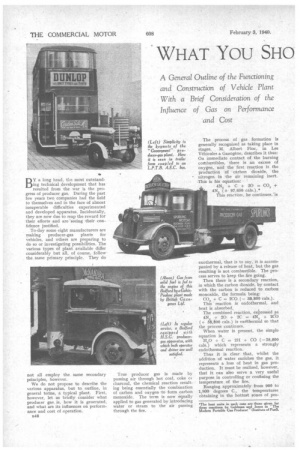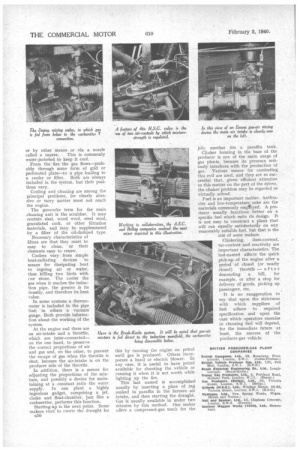WHAT YOU SHO D KNOW ABOUT PRODUCER GAS
Page 68

Page 69

Page 70

If you've noticed an error in this article please click here to report it so we can fix it.
A General Outline of the Functioning and Construction of Vehicle Plant With a Brief Consideration of the Influence of Gas on Performance
and Cost
Bny a long head, the most outstandDing technical development that has resulted from the war is the progress of producer gas. During the past few years two companies had the field to themselves and in the face of almost insuperable difficulties experimented and developed apparatus. Incidentally, they are now due to reap the reward for their efforts and are seeing their confidence justified.
To-day some eight manufacturers are making producer-gas plants for vehicles, and others are preparing to do so or investigating possibilities. The various types of plant available differ considerably but all, of course, follow the same primary principle. They do not all employ the, same secondary principles, however.
We do not propose to describe the various apparatus, but to outline, in general terms, a typical plant. First, however, let us briefly consider what producer gas. is, how it is generated. and what are its influences on performance and cost of operation.
e48 True producer gas is made by passing air through hot coal, coke ot charcoal, the chemical reaction resulting being essentially the combination of carbon and oxygen to form carbon monoxide. The term is now equally applied to gas generated by introducing water or steam to the air passing through the fire. The process of gas formation is generally recognized as taking place in stages. M. Albert Fioc, in Les Vehicules a Gazogene, describes it thus: On immediate contact of the burning cornbustibles, there is an excess of oxygen, and the first reaction is the production of carbon dioxide, the nitrogen in the air remaining inert. This is his equation:
4N, + C + 20 = CO, + 4N2 ( + 97,650 cals.).*
This reaction, he continues, is exothermal, that is to say, it is accompanied by a release of heat, but the gas resulting is not combustible. The process serves to keep the fire going.
Then there is a secondary reaction, in which the carbon dioxide, by contact with the carbon is reduced to carbon monoxide, the formula being: CO, + C = 2C0 ( — 38,800 cals.). This reaction is endothermal, and heat is absorbed.
The combined reaction, expressed as
4N5 + 20 + 2C = 4N, + 2C0 ( + 58,800 cals.) is exdthermal so that the process continues.
When water is present, the simple equation is
H20 + C = 2H + CO ( —28,800 cals.) which represents a strongly endothermal reaction.
Thus it is clear that, whilst the addition of water enriches the gas, it represents a loss of heat in gas production. It must be realized, however, that it can also serve a very useful purpose in controlling or confining the temperature of the fire.
Ranging approximately from 900 to 1,800 degrees C., the temperatures obtaining in the hottest zones of pro ducers vary and are not known with absolute accuracy. Design, fuel, and other factors affect this. Generally, about 1,000 degrees C. is a temperature at which a good gas is generated.
A. A. Appleby, in The Commercial Motor dated November 11, 1939, gave the following figures for the constitution of producer gas made with and without the addition of water, respectively; the figures are percentages: CO, 28; H2, 15; CH,, 2; N2, 50; CO2, 5, and CO, 30; H2, 5; CHA, 1; N2, 60; CO2, 4. The net calorific values, in centigrade heat units per cubic ft., of carbon monoxide, hydrogen and methane, respectively, are 187.5, 160 and 534.
Producer gas has a considerably lower heat value than petrol. Comparing the calorific values of mixtures, in each case, about to enter the engine cylinders (which is what matters) Fioc gives 600 cals. per cubic m. or a 50-50 producer-gas-air mixture and 800 cals. per cubic m. for a correctly proportioned petrol-vapour-air mixture. These values agree roughly w:11 the generally recognized power loss of 25-30 per cent.
This, incidentally, is allowing for the improvement effected in raising the compression ratio to a figure varying between 7 and 8i to 1, which is customary.
Although this loss of power must be accepted, unless a larger engine be installed, it is compensated to a small extent by. an improvement over petrol in pulling power and smooth running.
in this connection, and having a hearing on the question of costs, is the reduced loading space. There is not a great reduction, but the encroachment of producer and filter into pay-load space must be allowed for. Now that weight concessions have been granted, the loss occasioned by the increased unladen weight is not material.
As for operating costs, there seems to be no better scheme than to quote figures given by " S.T.R." in our issue dated December 2, 1939. For 30 m.p.h. four-wheelers and maximum-load four, six and eight-wheelers, doing 600 miles per week he gave these figurts, in pence per mile, for the total running costs on petrol, oil, and gas: 5-tonner—P. 4.53; 0, 3.96; G, 3.34. 7-8-tonner—P, 6.64; 0, 5.38; G, 4.56. 12-13-tonner P, 0,32; 0, 7.47; G, 6.43. 15-16tonner—P, 10.67; 0, 8.39; G, 7.08. They are based on the cost of solid fuel being equivalent to petrol at 5d. per gallon.
A vehicle in about the 5-ton class can be converted to operate on pro
ducer-gas for an all-in cost of about £120.
Now let us turn to the mechanical features of a typical vehicle producergas plant. Of three types, 'down. draught, up-draught, and cross-draught (self-explanatory terms) the producer is not greatly dissimilar from a domestic boiler and requires much the same sort of attention. There is a furnace part and a hopper. Upon the size of the latter depends the range of the vehicle on one filling.
Air is introduced through fire bars n19 or by other means or via a nozzle called a tuyere. This is commonly water-jacketed to keep it cool.
From the fire the gas flows—probably through some form of grid or perforated plate—to a pipe leading to a cooler or filter. Both are always included in the system, but their positions vary.
Cooling and cleaning are among the principal problems, for clearly abrasive or tarry matter must not reach the engine.
The gasworks term for the main cleaning unit is the scrubber. It may contain sisal, wood wool, steel wool, granulated cork, or other filtration materials, and may be supplemented by a filter of the oil-damped type.
Necessary characteristics of filters are that they must be easy to clean, or their elements easy to renew, Coolers vary from simple heat-radiating devices to means for dissipating heat to ingoing air or water, thus killing two birds with cne stone. The cooler the gas when it reaches the induction pipe, the greater is its density, and therefore its heat value.
In some systems a thermometer is included in the pipe line; in others a vacuum" gauge. Both provide information about the working of the system.
At the engine end there are an air-intake and a throttle, which are inter-connectedon the one hand, to preserve the correct proportions of air and gas and, on the other, to prevent the escape of gas when the throttle is shut, because the air-intake is on the producer side of the throttle.
In Addition, there is a means for adjusting the proportions of the mixture, and possibly a device for maintaining at a constant ratio the water supply. In one plant a highly ingenious gadget, comprising a jet, choke and float-chamber, just like a carburetter, performs this function.
Starting-up is the next point. Some makers elect to create the draught for this by running the engine on petrol until gas is produced. Others incorporate a hand or electric blower. In any case, it is useful to .have petrol available for shunting the vehicle or running it when it is not worth while lighting up the fire.
This last named is accomplished usually by inserting a piece of rag soaked in paraffin in the furnace air intake, and then starting the draught. Gas is usually available in under two minutes by this method. One maker offers a compressed-gas torch for the job; another fits a paraffin tank.
Clinker forming in the base of the producer is one of the main snags of gas plants, because its presence seriously interferes with the production of gas. Various means for combating this evil are used, and they are so successful that, given efficient attention to this matter on the part of the driver, the clinker problem may be regarded as virtually solved.
Fuel is an important matter. Anthracite and low-temperature coke are the materials commonly em"yed. A producer usually functions better on a specific fuel which suits its design. It is not easy to construct a plant that will run equally satisfactorily on any reasonably suitable fuel, hut that is the aim of some makers.
Clinkering, dust-content, tar-content and reactivity are important characteristics. The last-named affects the quick pick-up of the engine after a period of closed (or nearly closed) throttle — af ter descending a hill, for example, or after a stop for delivery of goods, picking up passengers, etc.
It is no exaggeration to say that upon the strictness with which suppliers of fuel adhere to required specification and upon the care which operators exercise in choosing fuel will depend, for the immediate future at least, the success of the producer-gas vehicle.








































































































